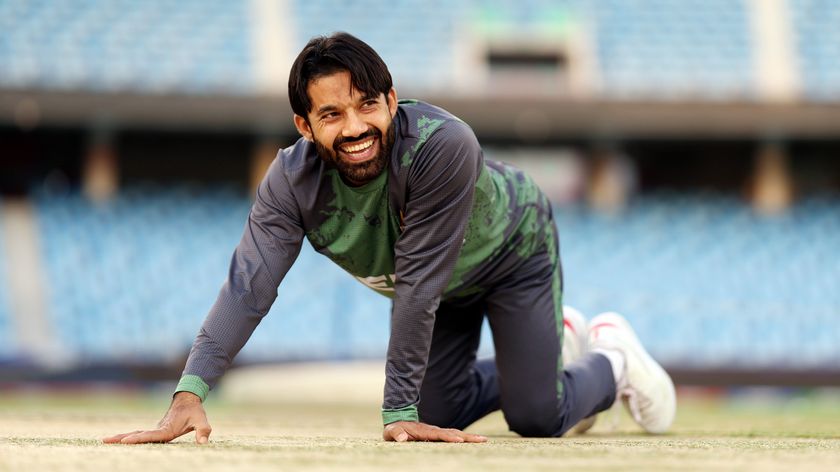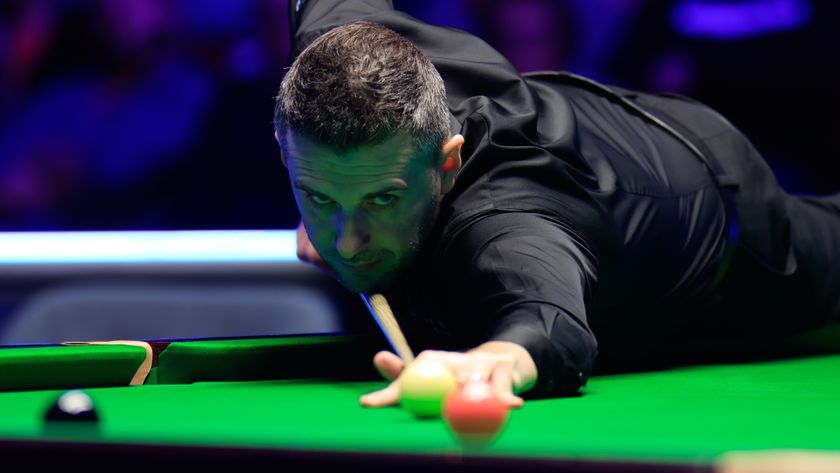TechRadar Verdict
The follow-up to the P10 has plenty of high points, not least the camera and hardware, but the Huawei P20 doesn’t quite have enough to compete with 2018’s best flagships. It seems the much better P20 Pro is doing that instead.
Pros
- +
Great camera
- +
Big battery with lots of stamina
- +
Optional (ish) notch
Cons
- -
No headphone jack
- -
No wireless charging or water resistance
- -
Pales next to the P20 Pro
Why you can trust TechRadar
Update: After Google suspended Huawei's future access to Android Play Store and security updates, there are serious question marks over the future of Huawei and Honor phones.
While Google and Huawei have promised to support phones currently on the market, it's not clear how long they'll receive Android updates or access to the Google Play Store, which would severely curtail their usefulness compared to the competition.
When it was first confirmed that the follow-up to the well-received Huawei P10 would be called the P20, our hopes were raised. Would skipping numbers P11 through P19 meant the new phone would be a huge jump forward – maybe even twice as good – as its predecessor?
Well, despite a stunning new design and a snazzy AI-enhanced camera, our hands on with the new P20 left us a little cold. After fully reviewing it and its bigger and pricier sibling the Huawei P20 Pro, our initial assessment has proved mostly correct.
Don't get us wrong, the Huawei P20 is a great phone in its own right, but it hasn’t moved far enough from the P10 to be a properly enticing buy for 2018 – especially when all the features we wanted have been implemented on the Pro and left off the spec sheet for the smaller phone.
Then there's the Huawei Mate 20 and the Mate 20 to consider, more expensive and yet also more capable. If you want the best phone that Huawei has to offer in 2018, you're not likely to be led to the P20.
Huawei P20 price and availability
- Launch price: £599, AU$999
- Not coming to the US
- Release date: April 2018
All of this is moot for people in the US, where Huawei phones are rapidly disappearing as a result of losing key vendor deals and potentially being shut out of government contracts.
Somewhat unsurprisingly in that climate, Huawei confirmed the P20 won’t be making an appearance in the Land of the Free.
It is, however, available in the UK and Australia and after launching at £599, AU$999 SIM-free, the Huawei P20 price has dropped to around £400 in the UK, making it more attractive. We've seen it for less than AU$700 in Australia too, though it's getting less easy to find.
In terms of budget that means it's rubbing shoulders with the likes of the LG V30 and is way cheaper than the likes of the Samsung Galaxy S9 and Google Pixel 2 XL. However, the slightly larger, more powerful Mate 10 Pro is around the same price, which means you've still got some thinking to do.
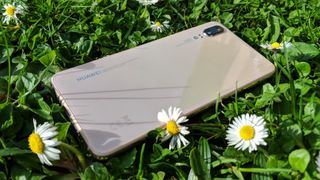
Looks Leica Huawei
- AI-enhanced camera
- Strong specs
- Gorgeous glass-backed gradient design
Launching at the Grand Palais in Paris, the Huawei P20 got off to a glamorous start. The big sell for the phone was the AI-assisted dual camera on the rear.
Weight: 165g
Dimensions: 149.1 x 70.8 x 7.7mm
OS: Android 8.1
Screen size: 5.8-inch
Resolution: 1080 x 2240
CPU: Kirin 970
RAM: 4GB
Storage: 128GB
Battery: 3,400mAh
Rear camera: 12MP + 20MP
Front camera: 24MP
Photography has been the main focus (pun intended) of the product line, with the continuation of the successful Leica partnership into the latest phone.
The P20 boasts two Leica Summilux lenses on the back, as well as a neural processing unit on the Kirin chipset, which provides the AI capability to the camera app. Huawei claims the AI function of the camera helps you become a better photographer, with suggestions and automatic mode-switching based on what the phone thinks you're trying to portray.
If that sounds a bit scary – and scariness is something Huawei should be hyper-aware of with its US reputation hanging in the balance – it's really not. It mostly just means when you're taking photos of a cat, the phone says "Hey! Cat!" and optimises the settings to get the best possible shot.
The camera also includes improved low light capabilities, including an AI-infused version of Super Night Mode that allows you to take amazing night shots without the need for a tripod or supernaturally still hands.
The P20 includes flagship-level hardware: alongside that octa-core Kirin chipset is 4GB of RAM and a super-generous 128GB of storage. The whole package is encased in a glass-backed, super-stylish handset in a choice of gradient finishes or, if you prefer, more ordinary colours. Boo.
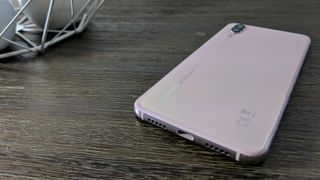
50 shades of gradient
- 149.1 x 70.8 x 7.7 mm, 165g
- Notched screen
- No headphone jack
There's no denying the P20 is an eye-catching phone. The very first time we took it out on the London Underground, a group of teenagers asked us what it was, and declared it a 'serious phone' (this is, we presume, a good thing).
We usually only get comments from strangers when we're carrying a OnePlus (which is treated a bit like a Nerd Club Membership Card), so clearly Huawei has done a good job on the design. Our review unit has the Pink Gold design, although realistically the gradient on that colourway is pretty subtle.
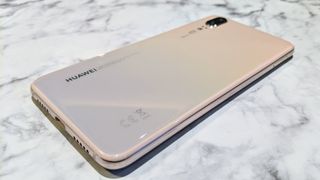
The hardened glass back of the handset has an opalescent pink finish that gives it a gorgeous mother-of-pearl look, and while not everyone will appreciate either the pink or the (slight) gradient, a lot of people would love a phone that looks like they found it on the beach.
That said, since it’s so smooth, the back does make this phone a slippery fish. You might want to put it in a grippy case if you don't want it sliding off tables.
The back panel is also unusual in that the Huawei logo and various bits of bumf that manufacturers have to include (logos, model numbers, that kind of thing) is written in landscape orientation, as is the Leica logo and camera info.
This has the effect of making the back look like a traditional landscape-oriented camera, with the lenses on the right replacing the viewfinder. The only thing missing is a Sony-style hardware shutter button, which would have ideally been included on the left. You can use the volume keys as shutter buttons, though.

The dual camera lenses (no third camera on this one – that's sadly reserved for the P20 Pro) are combined in a single oval enclosure which protrudes a millimetre or so. Flipping over to the front, you'll find the selfie camera at top centre, as per the 'notch' trend of this year (more on that below).
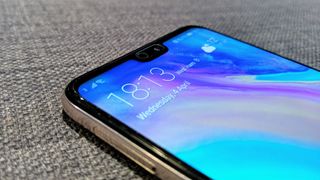
The black bezels around the screen are decently slim, though the bottom strip is still fairly sizeable due to housing the fingerprint pad (it's not pressable, sadly).
The phone comes with a screen protector pre-applied, which is a little annoying as you can clearly see its edges around the fingerprint pad and feel them when you swipe down from the top, but if you were going to put a protector on anyway, it's probably better than having a self-applied one full of bubbles and dust.
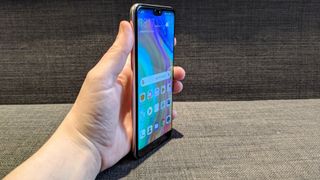
The rounded metal edges of the P20 have a light pink finish to them on our unit, with the SIM tray on the top left, volume rocker and power key on the right, and two sets of drilled holes (only one is a speaker) plus the centred USB-C port on the bottom edge. That's right, no headphone jack. Sorry.
Schrödinger's notch
- 5.8 inches, 1080 x 2244, 428ppi
- 18.7:9 aspect ratio
- TFT LCD
The FHD+ display on the Huawei P20 really does it proud. At 5.8 inches, it's a good compromise between a smaller phone and a phablet, while not feeling large in the hand because of the slim bezels and the notch.
Before anyone gets up in arms about it, the notch on the P20 is probably the least annoying we've seen. Huawei has smartly included a software option that blacks out the rest of the screen on either side, effectively removing the notch.
So whether you'd prefer the extra screen space or a more uniform look, this phone has you covered – and you might find you don't make the choice you expected. This phone actually converted us from a notch-naysayer: we just needed the option to turn it on and off until we worked out which we prefer. Whichever way you lean, it's definitely good to have options.
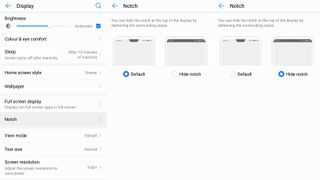
Which brings us to colour and light. The P20 has lots of options for customising the display to your liking: you can turn on 'natural tone' which adjusts colour temperature based on your environment; switch between Normal and Vivid colour; choose Default, Warm or Cold colours; turn on the Eye Comfort mode (for better sleep), and so on.
The brightness slider goes from what we'd call 'ridiculously dark' to 'pretty bright', or you can let the phone select its own brightness based on where you are. You can also bump the resolution down to save battery if you want to.
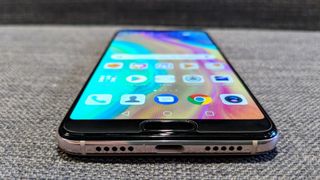
All of that said, we found the default settings looked great out of the box, so we didn't feel the need to do much fiddling with the settings.
The included wallpapers harmonise nicely with the colour scheme of the phone and show off the P20's colour reproduction to the full: shades, tones and shadows all appear crisp and vivid. Icons almost jump off the screen.
The 18.7:9 aspect ratio is a strange choice, but gives a tall display with plenty of room for content whether you have the notch on or off. You will find, however, that you need to manually switch quite a few apps into full-screen mode at first, because they're not always designed for such a long display.
The phone warns you that this might cause problems, but we didn't experience any – apps just restarted in the correct ratio and stayed that way. If you choose not to go full-screen, the black bar stays at the bottom to fill the rest of the space.
- Take a look at our Huawei discount codes for the best Huawei offers and savings.
Most Popular







